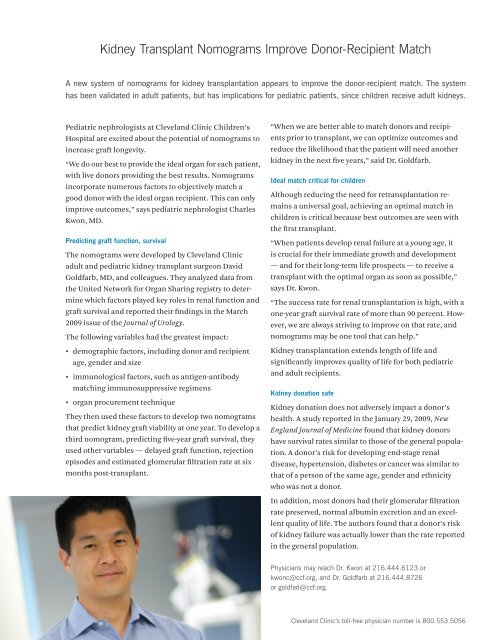Pediatric Perspectives Summer 2009 - Cleveland Clinic
Pediatric Perspectives Summer 2009 - Cleveland Clinic
Pediatric Perspectives Summer 2009 - Cleveland Clinic
Create successful ePaper yourself
Turn your PDF publications into a flip-book with our unique Google optimized e-Paper software.
<strong>Pediatric</strong> nephrologists at <strong>Cleveland</strong> <strong>Clinic</strong> Children’s<br />
Hospital are excited about the potential of nomograms to<br />
increase graft longevity.<br />
“We do our best to provide the ideal organ for each patient,<br />
with live donors providing the best results. Nomograms<br />
incorporate numerous factors to objectively match a<br />
good donor with the ideal organ recipient. This can only<br />
improve outcomes,” says pediatric nephrologist Charles<br />
Kwon, MD.<br />
Kidney Transplant Nomograms Improve Donor-Recipient Match<br />
A new system of nomograms for kidney transplantation appears to improve the donor-recipient match. The system<br />
has been validated in adult patients, but has implications for pediatric patients, since children receive adult kidneys.<br />
Predicting graft function, survival<br />
The nomograms were developed by <strong>Cleveland</strong> <strong>Clinic</strong><br />
adult and pediatric kidney transplant surgeon David<br />
Goldfarb, MD, and colleagues. They analyzed data from<br />
the United Network for Organ Sharing registry to deter-<br />
mine which factors played key roles in renal function and<br />
graft survival and reported their findings in the March<br />
<strong>2009</strong> issue of the Journal of Urology.<br />
The following variables had the greatest impact:<br />
• demographic factors, including donor and recipient<br />
age, gender and size<br />
• immunological factors, such as antigen-antibody<br />
matching immunosuppressive regimens<br />
• organ procurement technique<br />
They then used these factors to develop two nomograms<br />
that predict kidney graft viability at one year. To develop a<br />
third nomogram, predicting five-year graft survival, they<br />
used other variables — delayed graft function, rejection<br />
episodes and estimated glomerular filtration rate at six<br />
months post-transplant.<br />
“When we are better able to match donors and recipi-<br />
ents prior to transplant, we can optimize outcomes and<br />
reduce the likelihood that the patient will need another<br />
kidney in the next five years,” said Dr. Goldfarb.<br />
Ideal match critical for children<br />
Although reducing the need for retransplantation re-<br />
mains a universal goal, achieving an optimal match in<br />
children is critical because best outcomes are seen with<br />
the first transplant.<br />
“When patients develop renal failure at a young age, it<br />
is crucial for their immediate growth and development<br />
— and for their long-term life prospects — to receive a<br />
transplant with the optimal organ as soon as possible,”<br />
says Dr. Kwon.<br />
“The success rate for renal transplantation is high, with a<br />
one-year graft survival rate of more than 90 percent. How-<br />
ever, we are always striving to improve on that rate, and<br />
nomograms may be one tool that can help.”<br />
Kidney transplantation extends length of life and<br />
significantly improves quality of life for both pediatric<br />
and adult recipients.<br />
Kidney donation safe<br />
Kidney donation does not adversely impact a donor’s<br />
health. A study reported in the January 29, <strong>2009</strong>, New<br />
England Journal of Medicine found that kidney donors<br />
have survival rates similar to those of the general popula-<br />
tion. A donor’s risk for developing end-stage renal<br />
disease, hypertension, diabetes or cancer was similar to<br />
that of a person of the same age, gender and ethnicity<br />
who was not a donor.<br />
In addition, most donors had their glomerular filtration<br />
rate preserved, normal albumin excretion and an excel-<br />
lent quality of life. The authors found that a donor’s risk<br />
of kidney failure was actually lower than the rate reported<br />
in the general population.<br />
Physicians may reach Dr. Kwon at 216.444.6123 or<br />
kwonc@ccf.org, and Dr. Goldfarb at 216.444.8726<br />
or goldfad@ccf.org.<br />
<strong>Cleveland</strong> <strong>Clinic</strong>’s toll-free physician number is 800.553.5056

















